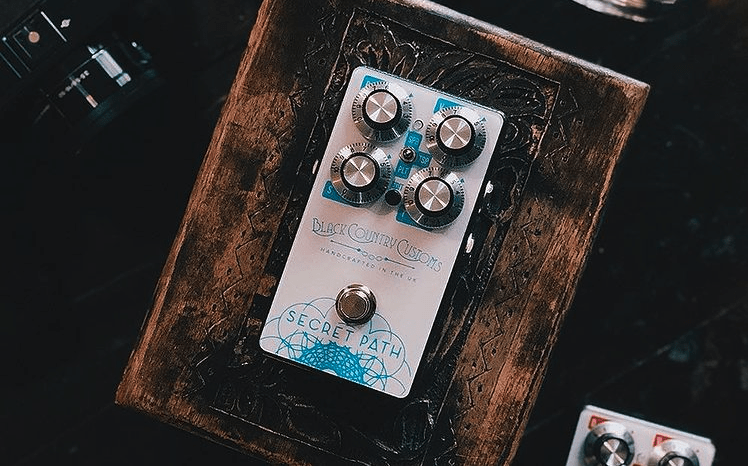The sound of great reverb pedals! We all love it. But WHY? What actually is reverb? What does reverb do to your sound? How do I choose a reverb pedal? Hint: It’s more than drenching your guitar solo in that nice echo that helps you imagine you’re playing at Wembley.
We’re bringing it right back down to basics today, with input from our in-house Tone Wizard, Simon Fraser-Clark. We’re talking about different types of reverb, how they’re created, and shouting about our personal favourite reverb pedal – the Laney Secret Path.
According to Wikipedia: Reverberation (also known as reverb), in acoustics, is a persistence of sound, or echo after a sound is produced.
Reverb is the phenomena of sound waves being reflected back to the listener from the environment around them. In a nutshell, it’s the sound carried on in the environment. The type of space defines the unique characteristics of the reverb – if you clap your hands in a small room, you’ll likely have zero reverb and hear a short sharp clap. Whereas clapping your hands in a large spacious room will often allow the sound to travel further and “carry on” causing reverberations.
The reflection reaching your ear tells your brain about the characteristics of the area – you’ll instantly understand whether it’s a small, closed-up room or a large church just by clapping, even with your eyes closed. We experience reverb all day every day, but we do not really notice it until we are in something like a large hall or a cavernous space when sound waves carry on. You cough and you hear a longer sound than you’re used to in a hall or church, for example.
From a musical perspective, a reverb effect provides a sense of space and overall weight. Where drum hits, guitar lines or even piano notes may sound dry and lifeless, reverb allows your musical notes and lines to decay later than they normally would, mimicking the effect of playing in a wide-open room. It can really elevate the note or sound being played. It adds flair and colour to your playing and in cases of certain bands such as Laney artist Sam Fender (who uses the Secret Path on his albums) creates a signature sound!
Reverb pedals emulate this effect to colour your tone, but also provide exceptional control over how long it takes for your sound to decay or “stop”.
Reverb is what makes an instrument played in a cathedral sound different from the same instrument played in a lounge bar. This effect is so important that players such as Brian May have called it ‘Hot Space.’ It basically fills the dead space.

There are 5 different types of reverb – Spring, Plate, Hall, Room and Chamber. However, there are two main reverb types, which have been turned into reverb pedals for guitarists and bass players – Plate and Spring reverb.
From a guitarist’s point of view, Reverb pedals can reproduce all the characteristics of these types of effects as long as they have the two main reverb styles – Plate and Spring.
In simple terms, here is a brief description of the main types of reverb:
Plate reverb was originally produced using a magnetic driver (think of a speaker coil) to drive vibrations in a large sheet of metal. The large metal plate vibrated via a signal passed from a transducer. The vibrations were then captured with a contact microphone. The result was dense and warm great for vocals and snare drums and can be heard all over early Pink Floyd albums.
Spring reverbs operate in a similar way to plate reverbs with a transducer at one end and a pickup at the other but employ a spring (or multiple) instead of a plate. Because of their small size, spring reverbs are often found in guitar amplifiers, although standalone spring tanks exist for studio use, too.
Spring reverbs yield a clean, bright sound, and are a must-have final touch for vintage-inflected guitar tracks.
Digital reverb systems are designed to replicate all the characteristics of natural reverb events with mathematical processes – essentially allowing you to meticulously dial-in decay and room size. Digital reverbs cannot perfectly recreate the effect of natural reverb. However, the developers of digital reverb systems have found several ways to deliver a convincing experience of space. There are generally two groups of digital reverb: algorithmic and convolution. We won’t go into these today!
It is safe to say that most modern reverb plug-ins that you’ll come across fall into the algorithmic category, most likely including any stock reverbs in your DAW. In general, any reverb plug-in not specifically marketed as a “convolution reverb” unit is algorithm-driven.
There are a LOT of reverb pedals out there. Watching demos, reading reviews and trying things out is the best way to find the right one for you.
Here are 3 key tips:
Whilst you’re here, we may as well shout about our personal and incredibly biased favourite! The BCC triple mode Secret Path Reverb pedal emulates a plate reverb, a spring reverb and also includes the ‘Secret Path’, which has a deep and mesmerising evolving sound. It’s super versatile, from small and subtle to grand and ambient effects. Check the demo below!
Updated 19th April 2022